History of Medway (Farthing Corner) services
< return to Medway (Farthing Corner) services
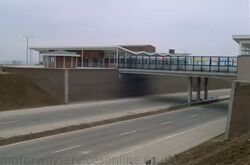
Medway shortly after it opened.

Medway services was opened as Farthing Corner, named after the nearby village. Traditionalists won't like any name change, but Medway at least has some circularity to it: the M2 was often referred to as the Medway Motorway, so the service area had already been colloquially referred to as the 'Medway Motorway Services' since it opened.
There was a lot of discussion about whether the M2, which is effectively a short bypass, was going to need its own service area. The M2 did need its own maintenance compound, and the plan was to leave this as an infill site to be turned into a service area later.
It was eventually decided to develop it into a full service area to prevent vehicles from taking the old road in search of facilities, although there were concerns doing this would put facilities on the A2 out of business.
While the Medway Towns Bypass was under construction, the Maidstone Bypass was already finished. That one, which is really Kent's first motorway, didn't get any service areas.
Identified Site
The likely place for the service area was close to Mount Lane in Hartlip, chosen because it was at the midpoint of the motorway, with two suitable half-sites opposite each other in a rural area with local access available. Consideration was given to developing only one side of the motorway, mainly for the sake of trying out a new idea.
Sites near Bredgar by the A249 were analysed, but it was decided they would never receive permission to build there. Building at M2 J4 was also looked at, but there were concerns this would overload the junction.
The Local Planning Authority objected to Hartlip because it would have ruined the views. Attention then turned to the current site at Farthing Corner, which was flat and would all fit within one field. Farthing Corner also attracted objections, with opponents claiming that the service area wouldn't be needed at all.
Tenders
The agreed site was 21 acres in size, of which only 12 were for developing: the rest would form picnic areas and embankments. There would be 48 toilets, two cafés and a restaurant. Tenders were then analysed based on their rent offer, fuel offer, catering offer, traffic flow, landscaping and company stability.
As the motorway is in a cutting at this point, it was generally agreed that the entire service area, including the buildings and the car parks, would be raised above the height of the motorway - a layout which is very rare in the UK. Normally the car parks would be built at road-level, but this would have been damaging and would lose the views of the countryside. This had the unexpected benefit that there is no risk of the buildings being struck by a vehicle, despite the former restaurant literally bordering the hard shoulder.
Kenning Motor Group
The firm responsible for Strensham made a bid for Medway. Their financial offer was poor.
Their restaurant would have sat 470, and deliberately avoided quick-service catering which they didn't feel would be suitable here.
Airborne Catering Ltd
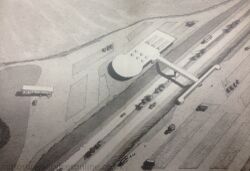
Airborne, the company who provided catering at Gatwick, made an excellent financial offer. They planned a restaurant with 540 seats and proposed a layout with good traffic flow.
However, their proposed amenity building was "too geometrical and without interest". Their architect was Sydney Clough, Son & Partners, who also worked for Top Rank.
Normand Ltd
Normand were a subsidiary of J Lyons & Co, who also owned Lyons Cakes. They had been encouraged to enter the industry, but their bid was described as "deplorable" and "inadequately presented".
Normand were told "significant changes" would be required if they were to build their proposal. Coach and lorry planning was far from the building. They planned a small restaurant on the bridge, seating 220, an idea that was called "interesting" and would go on to become a standard design.
Their plan had a transport café divided on each side of the waitress restaurant on the bridge.
Motorway Services Ltd
The Fortes/Blue Star partnership planned another large service area, with seating for 714. The restaurant would have been on the westbound side, a two-storey building with a café on the ground floor and a Grill & Griddle restaurant on the first floor, offering views over the valley. The eastbound side would be a single-storey building designed not to interrupt the view. The restaurant floor would have been tiled.
On the north side would be a promenade with a wide, paved terrace running around the perimeter.
They were thrown out because their plan offered a poor profit.
Rank
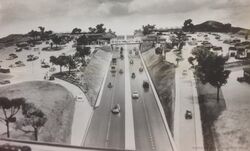
Top Rank were new to the industry and made an excellent financial bid. They were attracted to the site as they felt the forthcoming Channel Tunnel would increase the traffic levels, and they planned a restaurant with 468 seats and children's play area.
Their design was described as "imaginative" and their layout had good flow. They were working in partnership with a garage business, PDS of Worcester.
Their architect was Sydney Clough, Son & Partners. Their design, which turned the bridge into a terrace, is described below.
Rank won the contract.
East Kent Road Car Co. Objection
Just as the winning design was about to be announced, a curveball was delivered from an unexpected source: a coach company called the East Kent Road Car Co.
They claimed that they would be using the service area a lot, parking up to 40 coaches at any one time. The facilities that were about to be built would be completely inadequate. After some debate the Ministry decided to take their claim as an exaggeration, and to stick with their existing plans.
Opening
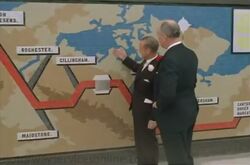
Farthing Corner services was officially opened on 29 May 1963 by Transport Minister Ernest Marples. It was built by George Wimpey. Upon opening, Rank described it as "gay and colourful", and intended the blue and yellow colours to offer a warm welcome to visitors to England. A government inspector told the Scottish Office that Farthing Corner is "at least presentable, even if it's not an outstanding contribution to the beauty of the country".
To showcase the best of rural England, the westbound (Londonbound) café was built with large windows, offering a wide view to the south. Named Channel Buffet, this café was open all night and set up for a high turnover, and had a blue colour scheme. The eastbound café was named Thanet Buffet, and was open from 7am to 10:30pm; it was a long, utilitarian room with orange and green plastic benches, and promised "modestly priced meals". The main restaurant was next door to this and open the same hours. Called Medway Restaurant, that one was quieter and had green, plastic settees and stools, with square counters in the middle; it offered a choice of à la carte or a set meal, and "far-reaching views over the sweeping Kentish countryside" and estuary. It called this "an exciting and memorable experience". There was no dedicated transport café; Rank argued that their cup of tea was better than that at any traditional transport café.
The facilities all provided multi-lingual menus, and staff wore old English-style hunting outfits. They were mustard and teal in colour. French newspapers and snacks were available. The kitchen used American toasters; a novelty in English catering.
Kent Messenger's Motorway Supplement, 1963
The front of both buildings had a large terrace area, with an umbrella-style building at the front, named Kentish Kiosk. This had a sign over the door promising: "cola, candies, cigarettes, ice cream, orange". On each carriageway the terrace had separate doors leading to the toilets and restaurant. Plans to advertise other Rank establishments from around the service area were refused, but a plaque and mural were unveiled, showcasing the local area.
Between the two buildings a wide bridge was initially provided between the two sides. This doubled-up as a sun terrace, with seats and large windows. This and the terrace offered a prime view of the new motorway, although Rank's leaflets claimed that it really offered "wonderful views of the surrounding countryside while the traffic speeds by beneath you". A diagonal pathway with awning over the top ran between the two sides. The press praised the building's "emphasis on relaxation".
The eastbound service area had a picnic area with a kiosk which was only opened three times a year. People were walking up to the fence to get a view of the Medway Estuary. There was a picnic area by the westbound exit too, which was surrounded by woodland, but was also barely used. These opened in June 1963.
It cost Rank £350,000 to build the service area, almost four times more than the government had asked them to spend and around £6million in 2025. Despite it being ready to handle coaches and cross-channel traffic, on an ordinary day the majority of customers would turn out to be locals.
Changes
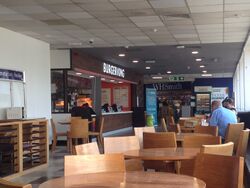
Within a year of it opening, the Ministry of Transport accepted there had been "considerable criticism" of the road signs they had provided around the service area. The vast majority of these involved the westbound exit to the M2, where a sign directing traffic around the petrol station was inadvertently sending people into the maintenance compound. A new signage scheme was soon drawn up. This continues to cause problems, even today, as the main circulatory road feeds too perfectly into the Rear Access.
The service area initially became known for being particularly dirty, and was described by inspectors as "sleazy". One of the takeaway kiosks was converted to Wimpy in 1968.
Farthing Corner didn't turn a profit for many years, and was operated on tight margins until the Prior Report of 1978 changed its rent agreement. To celebrate what was a new era for their industry, the following year Rank provided a thorough refurbishment. This was likely to be the date the bridge was given its roof. Changes like this, including maintaining the building that borders the motorway, have become increasingly challenging as more safety rules have come in.
Egon Ronay, 1977
Once the bridge was covered up, the two buildings became one, with the bridge area now forming the majority of the public area. Thanks to the car parks being so high, the new arrangement created an unique layout where a single-storey building straddles the motorway, and where customers can stroll from one car park to the other without needing to climb any large flights of stairs. In practice, that meant the facilities on each side could be consolidated, as the walk from one side to the other was so convenient. It did also mean customers would forget they had crossed the bridge, and use the wrong exit.
During the 1980s, the parking was rearranged to break up the large car parking areas, providing large coach parking areas instead, although these days this space is used almost entirely as an overflow HGV parking area. The westbound car park was also expanded over the only grass area. The restaurant became branded Highway Inn, with a takeaway unit called Highway Express.
Further changes were made a few years later, with the restaurant now called Oasis, the takeaway now called Just A Minute, the transport café called Yorkie's and the shop now branded Supershop. The service area was allowing coaches to empty their toilets for free, in the hope this would bring more trade.
Photos after it was taken over by Pavilion in 1992 show the bridge having beige tiled flooring with fixed seating, and a shop called Pavilion Store at the end. The restaurant had a red carpet, fixed red seating and large green signage. The entrance had dark brickwork and frames, with less signage and no window decals. Signage welcomed customers in England and French.
With the additional floorspace gained by putting a roof over the terrace, the rest of the amenity building has hardly expanded at all. The dining area on the bridge later became Burger King. A Little Chef was added in 1996 and removed in 2008. A Bureau de Change has been removed from the service area too. The Costa outlet was moved in January 2015, making way for the M&S Simply Food store.
One of Rank's first budget hotels, the Top Rank Motor Lodge, was built in the woodland in place of the old westbound picnic area in 1987. It later became Pavilion Lodge, Granada Lodge, and then Travelodge.
The petrol stations were both rebuilt in the 1990s. The eastbound car wash was demolished in 2022. Another old garage building, on the westbound side, was used as 'The Centre' and more recently by North Kent Counselling.
On 3 December 2010 the building at Medway suffered a broken window due to storm damage. This caused the M2 below to be closed, with traffic being diverted through the service area.
Despite being right outside the entrance, the takeaway kiosks were boarded up and painted Moto's turquoise. They were both demolished in 2012, being replaced by giant i-media advertising displays.
The M20 Effect
Rank, 1973
In 1973, Rank weren't pleased with the news that the completion of the M20 was going to see some of their trade diverted onto the new road. They were denied compensation because their contract never promised that the M2 would always be the main road to Dover, even though Rank had factored that assumption into their design.
The effect of the opening of the M20 is clear. It's not so much that trade dropped, but that it didn't rise quickly like it had done at so many other service areas. By the 1990s this had turned Farthing Corner into a bit of a pleasant, forgotten backwater. Its large coach park now seems unnecessary and almost taunts it for the days where this was a major holiday route.
The eastbound side received a small extension in 2002, adding facilities and attempting to attract more people making shorter journeys.
Survey Results
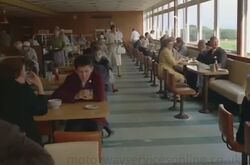
In 2025, Which? Magazine ranked Medway 57th out of the 90 service areas they visited.
The 2022 Transport Focus survey calculated a 97% satisfaction score for the westbound service area, and 99% for the eastbound service area. This placed the eastbound side in the top five, a large rise from the previous survey. The following year, the scores were 97% and 94% respectively.
The Spring 2018 Transport Focus scores were 97% satisfaction from westbound customers, and 85% satisfaction from eastbound customers. In 2019 the westbound score fell to 86%.
In 2015 and May 2012, VisitEngland rated the service area as 3 stars. In August 2011, they gave them 2 stars.
In 2006 the service area won a four star loo award.
In 2004, Good Housekeeping rated the service area as one star, describing it s "depressing", "dreary" and "unpleasant", but the busy Little Chef restaurant apparently served good food.
In 2001, the service area were rated "acceptable" by The AA.
Which? review, 1991
In 1991, Which? told motorists to avoid the service area, complaining about views of the motorway, long queues and poor service. It came last out of their sample, meaning it was widely reported to be the worst service area in the country.
Egon Ronay graded it as "acceptable" in his 1990 guide. He said it was "uninsipring on the outside and dated on the inside".
Glasgow's Daily Record called it "one to avoid" when they visited in July 1984, saying it was too small for the large number of visitors, with litter, the takeaway closed, and dirty toilets.
A 1978 government review described the service area as "depressing".
In 1977 Egon Ronay rated the service area as "poor". He said the café felt like an "amateurishly-run transport café", the food was "unimaginative" and it "all seemed rather scruffy", with a jukebox which "can be unpleasant".